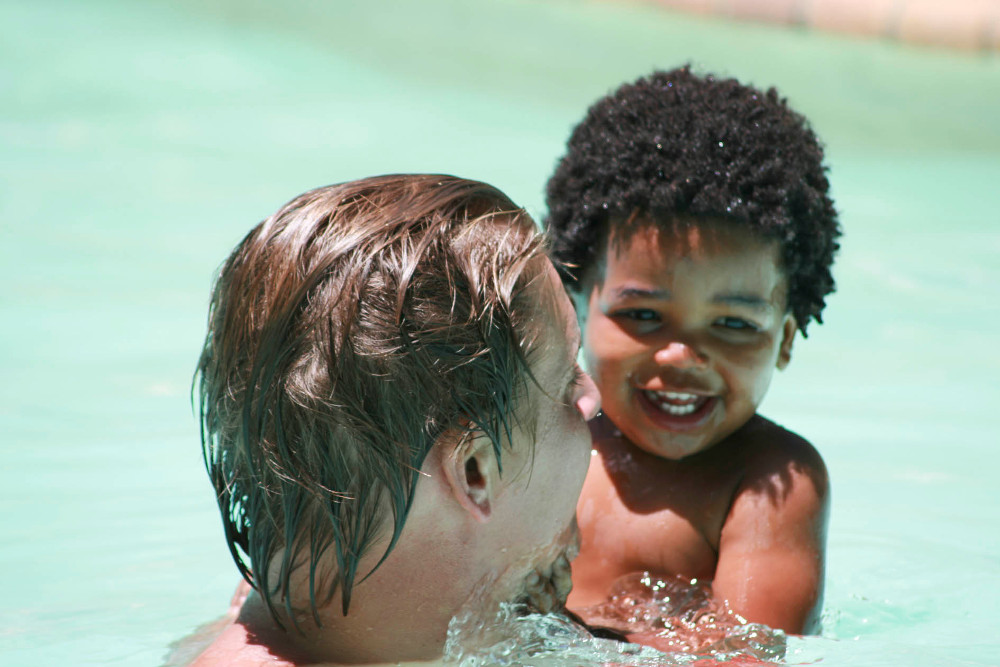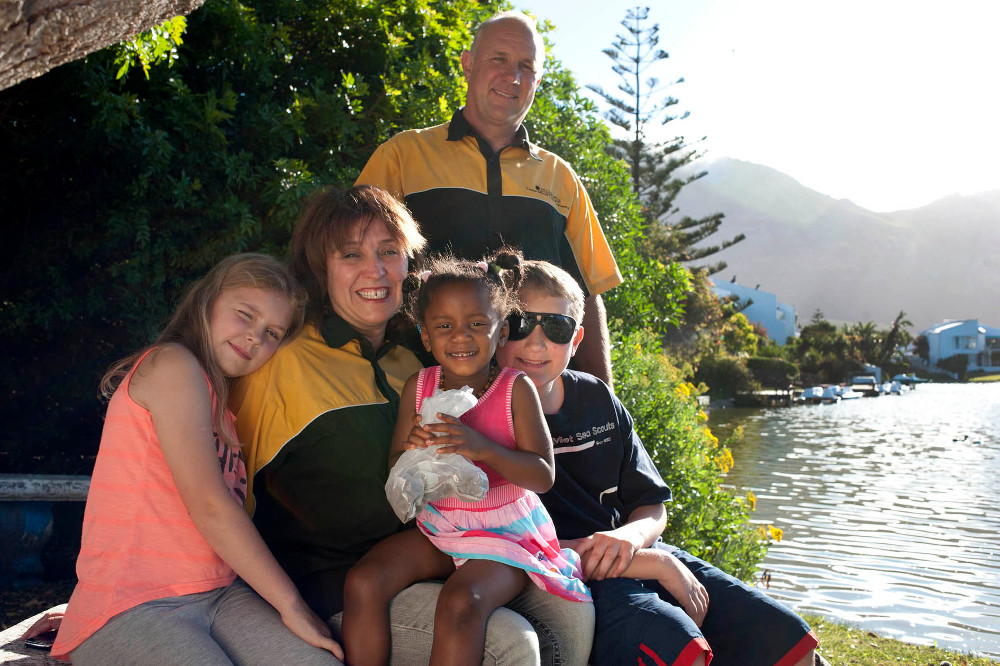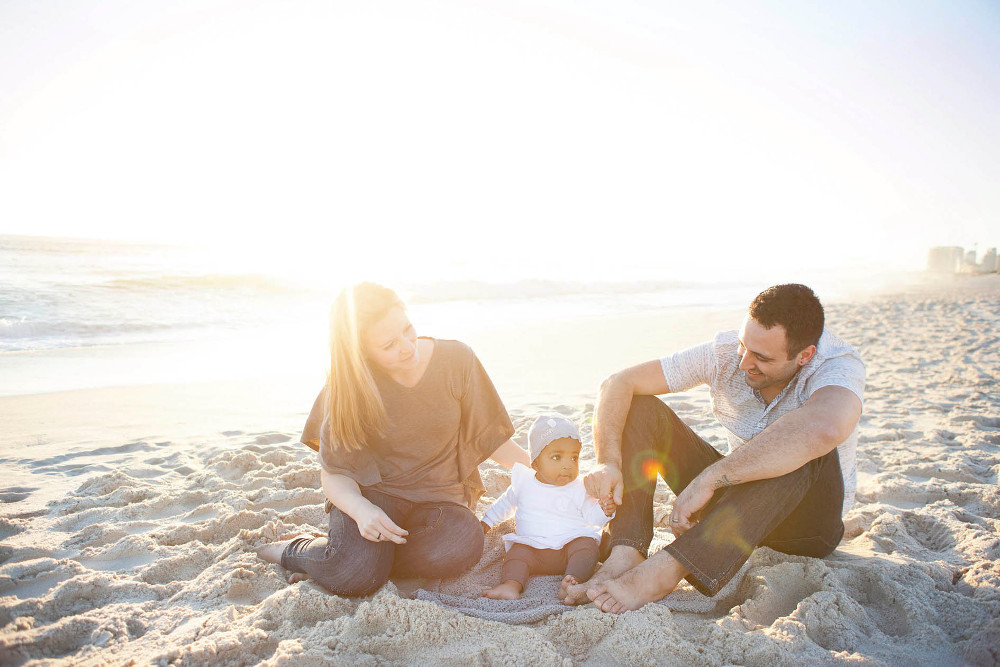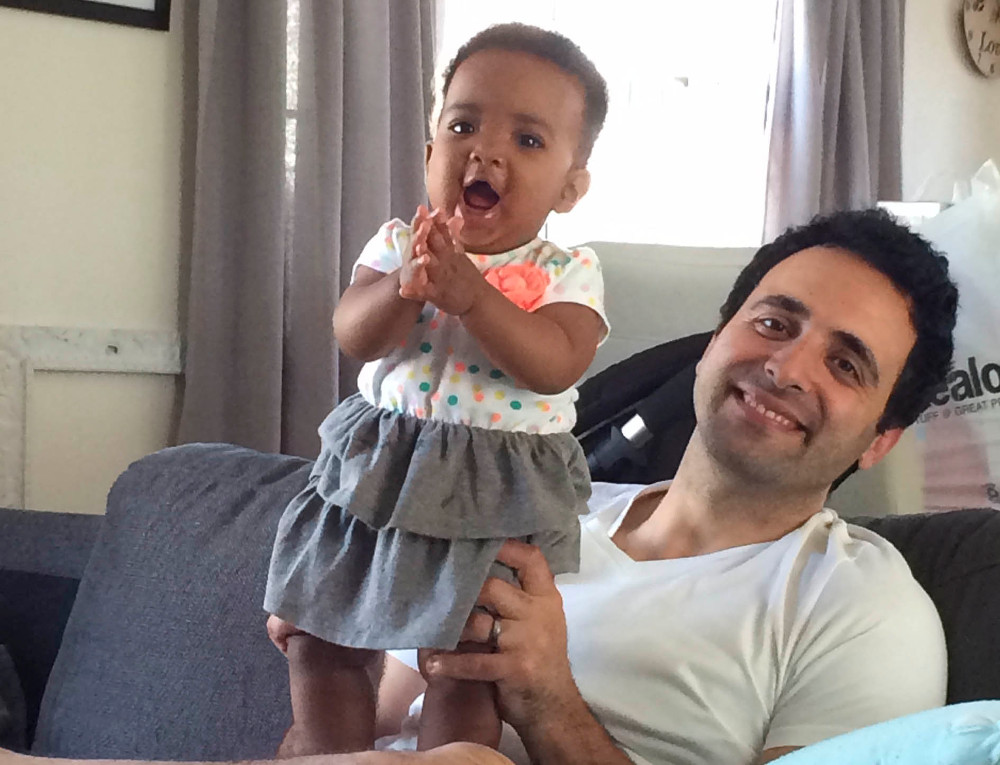Alex Hoek says everything appears normal to his son Quentin
Sometime in the 1960s, South African photographer Ernest Cole snapped an evocative shot of a black domestic worker holding a white infant on a park bench in Johannesburg, the two of them wrapped in a warm and effortless embrace. “I love this child, though she’ll grow up to treat me just like her mother does,” the caption reads. “Now she is innocent.”
Five decades later, in a wealthy suburb probably not far from where Cole’s photo was taken, Alex Hoek shows me a different image, of himself with his infant son Quentin. This time, the races are reversed: the adult is white, the child black. But, as in Cole’s image, father and son are holding each other in a way that suggests simple joy and intimate reliance.
As I’ve crisscrossed Johannesburg over the past few weeks interviewing families like Hoek’s, who have adopted transracially, my mind has wandered between these two photographs.
In one sense, of course, the worlds they represent could not be more different – the rigidly segregated world of apartheid on the one hand, a glittering “post-racial” democracy on the other. But there’s also something similar about them, in what both hint at about the profound ways in which children foil notions of racial difference in this country – simply by not recognising their existence.
“To Quentin, this is what normal looks like,” Hoek says of his six-year-old son. “He knows that his skin is dark and mine is light but it doesn’t mean anything to him.”
Fraught topic
Transracial adoption is a fraught topic in any country – subjected to seemingly endless hand-wringing about culture, difference and belonging – but the issues it poses are acute in South Africa. After all, to adopt a child of a different race from you is to say that, in building a family, skin colour doesn’t matter – a bold proclamation in a place where only a generation ago it determined nearly everything.
Transracial adoption in South Africa has another distinctive feature: this may be the only country in the world where a racial minority regularly adopts from the racial majority. “South Africa is unique in that way,” says Pam Wilson, head of adoptions at Johannesburg Child Welfare.

Alex Hoek and his son Quentin.
“It means that a black child adopted by a white family is never going to be totally cut off from his roots – all around him are people who look just like he does.”
That isn’t to say, however, that transracial adoption is a social worker’s ideal choice. For black South African children waiting to be adopted, the gold standard is a married black couple, Wilson says.
After all, the argument goes, an adopted child will already grow up dealing with the wrenching fact of having been abandoned, so why add further confusion?
Colour stipulations
But there’s a basic issue – supply and demand. At the moment, for instance, there are 520 children on a waiting list to be adopted in South Africa – all but 21 of them black. Meanwhile, of the 351 prospective adoptive parents, which includes 14 black families, 215 white families, 72 Indian families and 50 coloured or other families, just 70 are willing to adopt a black child, whereas 61 will take a “mixed race” child, and 119 a coloured child – the rest are waiting for the rare prospect of a white or Indian child. (Mixed race apparently refers to a child with parents who are of two different races, and coloured refers to a child with two coloured parents.)
It means that if a family is willing to adopt transracially, race is almost never a stumbling block in the adoption process.
Wendy Purdon and her partner Charles de Jongh were one of those families. After almost exhausting their bank accounts and their sanity trying to get pregnant, they decided three years ago to adopt, and told their social worker that they would take any child who needed a home. Within five months, the couple had a daughter, Abby.
“That hole that I’d been trying to fill for such a long time, suddenly it was filled,” Purdon says. “To me it’s outrageous that there are so many families who want so badly to have children, but would rather wait [for a baby of the same race] than to have another human being in their house to love.”

For couples like Wendy Purdon and Charles de Jongh, adoption presents an opportunity to expand their family and provide a home for a child in need. (David Harrison, M&G)
To grow up adopted – transracial or not – is to straddle two worlds. They have a childhood almost indistinguishable from any other, mapped out across school years and sibling rivalries and adolescent rebellion. But very often for adoptees this life becomes entangled with another, equally powerful one – the life that could have been. There, in the soft-focus world of the imagination, it tugs constantly at the edges of their reality with a single question: What if?
“I think all the time about what it would have been like to grow up in China,” my sister Zoey told me recently. It’s been nearly two decades since our parents brought her home to Denver, Colorado, in the United States, from a Chinese orphanage in the city of Changsha, a round-faced and eerily quiet 11-month-old who had been taught never to cry.
Today, 19 years old, she chats with me on Skype. She’s wearing a T-shirt emblazoned with the logo of the private American university she attends, full of news about go-kart racing with friends and her course schedule for the semester.
“Were my parents poor? Were they young? Why did they have to give me up? I don’t know any of that,” she tells me. “Sometimes it’s hard to deal with, this feeling that your parents just didn’t want you, especially when you look around [your adopted family] and see that no one looks like you, that you’re different in this way.”
US policy
In the US, transracial adoptions – a category that includes domestic adoptions across race and international ones like Zoey’s – account for almost 30% of total adoptions. Since the practice became legal in South Africa in 1991, the figure here has hovered around 10%.
In societies so self-consciously concerned with diversity, that inevitably gives way to questions of cultural appropriation. In the US, the National Association of Black Social Workers has fiercely opposed interracial adoption since the 1970s.
“People sometimes say that you’re taking away the child’s culture by raising them like you would white children, but what kind of culture do you get if you grow up in a children’s home?” asks Mary Cruickshank, who has six adopted children (five were transracial adoptions) in addition to four biological children, and runs a support group for families who adopt transracially. “Does it matter what language and culture a child has as long as they have a loving family?”

Sarah and Domenico Cosentino with their baby, Isabella Grace. Sarah says it is not clear what it means to teach a child ‘their own culture’. (Katherine Newman)
Many adoptive parents say it’s not always clear what it means to teach a child “their own culture”.
“Culture is such a difficult issue. Am I meant to teach her about Xhosa culture or is it a more general black African culture?” asks Sarah Cosentino of Cape Town, who adopted her infant daughter Isabella Grace in May.
“I think it’s just important that she sees how many different experiences there are in this country, and how unique each family is.”
Cross-cultural existence
Few people understand what it means to stand astride many different South Africans as well as 24-year-old Stan Malindi, who is completing a master’s in politics at the University of the Witwatersrand.
Although his biological father was Venda and his mother Pedi, he spent much of his childhood in a Soweto children’s home where “there were all kinds of languages and cultures”, he says.

Isabella Grace with her adoptive father, Domenico Cosentino. (Katherine Newman)
By the time he was adopted at the age of 13, he spoke English, isiZulu, Sesotho and Setswana. His adoptive parents added a few more cultural wrinkles: one is white, the other coloured, and both are women.
“I can’t really say I subscribe to any one culture at this point,” he says, laughing. “Mostly that’s good, but occasionally, of course, you yearn to just identify as one thing.”
But Zeenat Bhikhoo (27), who is coloured and has Indian adoptive parents, says she’s largely at peace with how she fits into the world around her.
“People are always telling me I should go find my roots,” she says. “But my roots are with my family. I mean the ones who raised me.”
Higher hurdles for potential parents of different race children
The sometimes bruising bureaucratic hurdles of parenthood begin long before adoptive parents ever meet their child.
Prospective parents undergo a barrage of tests, interviews and legal clearances before they adopt, says Pam Wilson, head of adoptions at Johannesburg Child Welfare.
In the case of transracial adoptions, those screening the applicants are particularly careful.
“You don’t want a situation where a [white] family wants to adopt a black baby to make a political statement, or a situation where they feel like they’re settling for a black child,” she says. “This isn’t some experiment – this is a child’s future.”
Adoptions in South Africa are processed by private and government agencies – the former being faster but more expensive – but in every case, the process is essentially the same. Social workers hold a magnifying glass to the lives of prospective parents, poking into their medical histories, mental health and the stability of their relationship, if they are adopting as a couple. They collect references and sift through police records, and then the social worker conducts a home visit.
Meanwhile, social workers also meet the birth parent or parents planning to give the child up for adoption.
“We really try to take their wishes for their child into consideration – so if they don’t want a same-sex couple adopting, or a single parent, we try to respect that,” Wilson says. “But that said, we will never leave a baby waiting too long for a home if one is available, so there are certainly times when we will override the birth mother’s wishes if it’s in the best interest of the child.”
Under South African law, birth parents also have 60 days to change their mind about an adoption. In the case of abandoned children, or when the father is unknown, agencies are obligated to place newspaper ads seeking the infant’s extended family – and then observe a mandatory three-month waiting period for a response – before allowing them to be adopted by a nonrelative.
For families adopting within their own race, they are frequently matched immediately to a child after they complete screening, but transracial adoptive parents must undergo a final hurdle. They are placed on the Register of Adoptable Children and Adopting Parents, a waiting list for babies and families for whom a “gold standard” – that is to say, same-race – placement isn’t immediately available.
Most of the parents on the list are waiting for white or Indian children, Wilson says. Those interested in black or coloured children rarely stay in the queue for long – once adoption agencies determine that the transrace parents are the best available family, the adoption is quickly processed.